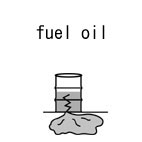| Case Name |
Outflow of 43000 kL fuel oil into Setonaikai sea caused due to a crack at the base plate of a tank |
| Pictograph |

|
| Date |
December 18, 1974 |
| Place |
Kurashiki, Okayama, Japan |
| Location |
Refinery |
| Overview |
The base plate of a fuel oil tank in use ruptured on December 18th, 1974. 43,000 kL fuel oil leaked and flowed out over the oil-retaining wall. In previous March, a filling water leak test was performed at the time of completion of the tank, and under part of the base plate of the tank was excavated to install independent stairs with water filled. The base plate broke under the influence of this construction. Corrosion was also generated after only nine months. |
| Incident |
A new tank ruptured about nine months later after it was first used. A large volume of fuel oil flowed out rapidly due to a crack generated at the tank base plate. A part of the oil-retaining wall was damaged. About 43,000 kL fuel oil flowed out of the wall. An oil-retaining wall was installed around the fuel oil tank. However, as the iron stairs were blown away and destroyed the wall, so fuel oil flowed into the Setonaikai sea through the drain. Refer to Fig2. |
| Processing |
Storage |
| Substance |
Fuel oil |
| Type of Accident |
Leakage, environmental pollution |
| Sequence |
In March, 1974. The fuel oil tank where the accident occurred started being used.
On December 18th. The tank ruptured suddenly during usual use. About 43,000 kL of fuel oil flowed out. |
| Cause |
Construction of independent vertical stairs for the tank was planned after construction of the main part of the tank was completed. To make the foundations for the vertical stairs, about 5 m along the tank circumference and about 0.4 m from the side wall in the direction of the center were excavated. The foundation was placed at a time of a water level of 12 m. Although the foundation was buried again after construction, it is assumed that the soil beneath the tank had not fully hardened due to the difficulty of the work. For this reason, local subsidence of the basic foundation due to the load of the tank advanced. Therefore, an excessive load operated on the main part of the tank. It is concluded that the tank finally ruptured. |
| Response |
Although extension of oil fences was attempted during the night, work ran into difficulties due to the strong wind and waves, and a lot of spilled oil. |
| Countermeasures |
Various design manuals, design criteria, and related statutes were revised to prevent a structurally excessive load from being generated.
Differential settlement is measured at the time of overhaul inspection.
This accident was based on unusual stress concentration.
Generally, strength reduction of components due to age deterioration will be limited to a safe range. Suitable repairs are also required to be made as needed. |
| Knowledge Comment |
The load of a tank is concentrated near the bottom end of one side. The junction of an annular wall and a base plate tends to be a weak point. Stress concentration into the portion has to be avoided.
An outflow was expanded by destruction of the oil-retaining wall.
During difficult work, inspections and checks are also difficult. |
| Background |
There was a mistake in the construction plan. It is out of the question to excavate a tank bottom after completing the tank. Furthermore, the original construction plan was a problem to lead to such a schedule. It is assumed that there was a problem in the schedule for first use of the tank and cost. |
| Sequel |
This major accident was a reason for a legal revision which introduced a double oil-retaining wall for oil. |
| Incidental Discussion |
It was an accident that should not have happened. Although the foundation was placed at a water level of 12 m according to the sources of information, was excavation also performed with oil inside? It is problematic to make major excavations at the bottom or the circumference of a completed tank. It may only induce an accident. It is also a problem if welding is done later at the main part of a tank. |
| Reason for Adding to DB |
Example of leakage caused due to destruction of a tank from reckless construction |
| Scenario |
| Primary Scenario
|
Organizational Problems, Inflexible Management Structure, Schedule and Budget Prior, Poor Value Perception, Poor Safety Awareness, Inadequate Risk Recognition, Insufficient Analysis or Research, Insufficient Practice, Lack of Imagination, Planning and Design, Poor Planning, Poor Design, Malicious Act, Rule Violation, Safety Rule Violation, Bad Event, Mechanical Event, Stress Concentration, Failure, Large-Scale Damage, Destruction, Secondary Damage, Damage to Environment, Sea Pollution fuel oil 43,000 kL, Loss to Organization, Economic Loss
|
|
| Sources |
The Japan Soc. for Safety Engineering edition. Asamichi Kamei, Case of damage to oil tank and the preventive measure, Accident examples of fires and explosions, pp.172-179 (2002).
Japan Assoc. of Fire Science and Engineering, Case of major oil spill. Tank fire, Basic knowledge and accident prevention activities No.3, p.43 (1990).
|
| Physical Damage |
Serious damage to culture of laver, wakame seaweed, and yellowtails etc. |
| Consequences |
A large volume of fuel oil flowed into Setonaikai sea, causing environmental pollution. |
| Multimedia Files |
Fig2.Destroyed annular plate
|
| Field |
Chemicals and Plants
|
| Author |
ITAGAKI, Haruhiko (Japan National Institute of Occupational Safety and Health)
TAMURA, Masamitsu (Center for Risk Management and Safety Sciences, Yokohama National University)
|